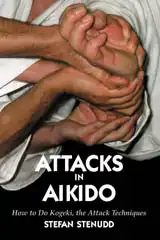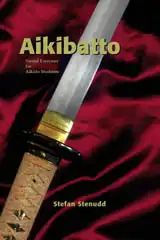KokyunageThe aikido technique kokyunage, breath throw, against different attacks
Kokyunage is a throw with numerous variations and not really one basic form. Therefore, I show several different versions on this video. I mostly show it rather slowly for clarity, usually gotai (from a static starting point). But there is also some jutai (moving as the attack approaches). In most cases, there is little difference between gotai and jutai versions of kokyunage, except the timing.
Breath throwKokyunage simply means “breath throw”, indicating that it is more about rhythm and flow than about force. Still, the throws can be quite powerful.The kokyu breath is abdominal breathing where you focus on your center (tanden). This is the power breathing used in all budo. In aikido, it's often called kokyu ryoku, which simply means breath power. Kokyu actually means breathing out and breathing in. That's how breathing is done, of course, but it also says something about how kokyunage works: You sort of take in the attacker's force and then return it in the throw. You should not need to grab the attacker to be able to throw him or her in kokyunage. Instead, use the momentum of the attack for the throw, or the attacker’s commitment to a grab. Sure, that can be said about most aikido techniques, if not all of them – but it’s particularly evident in kokyunage.
Strikes vs. grabsWhen the attack is a strike, there is no gotai version, from a static position. You need to initiate before the attack reaches, which is jutai. The rhythm of it is essential in kokyunage, with an acceleration at the end, when you make the throw. It is almost the rhythm of a whip.On grip attacks, both gotai and jutai are possible. It's good to practice both. If you only practice jutai, you may get stuck if the attacker happens to grab you. If you only practice gotai, you will have difficulty learning the rhythm of the kokyunage throw. There is little difference between the gotai and jutai versions of kokyunage, except for the beginning. In both you start by the taisabaki evasive move and joining with the force of the attack in the spirit of breathing in — whether you actually inhale or not. Then you redirect it into the throw while breathing out — and you should definitely exhale at that point.
Ki nagareKokyunage is an excellent technique for ki nagare, where you just keep going instead of stopping after each throw. The flow comes quite naturally with this aikido technique. It's like waves continuing forever to roll in from the sea.That means kokyunage is also a good choice for taninzugake, defense against several attackers. On aikido demonstrations it's very common to use just kokyunage on ryo katadori (double shoulder grip) attacks, when taninzugake is shown. Also on dan gradings.
AIKIDO PRACTICEIntroductionAikido Techniques — all the basic movesAttacks in Aikido
Tantodori — knife defenseAikiken — aikido sword techniquesJo 31 Kata in four directionsAikibatto sword and staff exercisesAiki — joining energiesKi exercisesAikido Video ClipsAikido PhotosMy aikido dojo in Malmö, SwedenMy aikido seminarsAIKIDO THEORYMy Aikido BioAikido GlossaryTanden, the CenterAikido InksAikido as Self-DefenseRunning a DojoAikido is TrueOsensei and EinsteinAikiWeb ColumnsAikido Books ReviewedDie deutsche Version meines Aikido-Buches onlineAikido på svenskaAbout CookiesMy Other WebsitesCREATION MYTHSMyths in general and myths of creation in particular.
TAOISMThe wisdom of Taoism and the Tao Te Ching, its ancient source.
LIFE ENERGYAn encyclopedia of life energy concepts around the world.
QI ENERGY EXERCISESQi (also spelled chi or ki) explained, with exercises to increase it.
I CHINGThe ancient Chinese system of divination and free online reading.
TAROTTarot card meanings in divination and a free online spread.
ASTROLOGYThe complete horoscope chart and how to read it.
MY AMAZON PAGE
MY YOUTUBE AIKIDO
MY YOUTUBE ART
MY FACEBOOK
MY INSTAGRAM
MY TWITTER
STENUDD PÅ SVENSKA
|
 Aikido Principles
Aikido Principles Attacks in Aikido
Attacks in Aikido Aikibatto
Aikibatto
